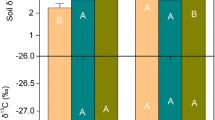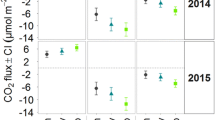Abstract
Woody encroachment into herbaceous ecosystems is emerging as an important ecological response to global change. A primary concern is alterations in C and N cycling and associated variations across a variety of ecosystems. We quantified seasonal variation in litterfall and litter N concentration in Morella cerifera shrub thickets to assess changes in litterfall and associated N input after shrub expansion on an Atlantic coast barrier island. We also used the natural abundance of 15N to estimate the proportion of litterfall N originating from symbiotic N fixation. Litterfall for shrub thickets ranged from 8,991 ± 247 to 3,810 ± 399 kg ha−1 year−1 and generally declined with increasing thicket age. Litterfall in three of the four thickets exceeded previous estimates of aboveground annual net primary production in adjacent grasslands by 300–400%. Leaf N concentration was also higher after shrub expansion and, coupled with low N resorption efficiency and high litterfall, resulted in a return of as much as 169 kg N ha−1 year−1 to the soil. We estimated that ∼70% of N returned to the soil was from symbiotic N fixation resulting in an ecosystem input of between 37 and 118 kg ha−1 year−1 of atmospheric N depending on site. Considering the extensive cover of shrub thickets on Virginia barrier islands, N fixation by shrubs is likely the largest single source of N to the system. The shift from grassland to shrub thicket on barrier islands results in a substantial increase in litterfall and foliar N concentration that will likely have a major impact on the size and cycling of ecosystem C and N pools. Increasing C and N availability in these nutrient-poor soils is likely to permanently reduce cover of native grasses and alter community structure by favoring species with greater N requirements.



Similar content being viewed by others
References
Aber JD, Melillo JM, McClaugherty CA (1990) Predicting long-term patterns of mass loss, nitrogen dynamics, and soil organic matter formation from initial fine litter chemistry in temperate forest ecosystems. Can J Bot 68:2201–2208
Archer S, Schimel DS, Holland EA (1995) Mechanisms of shrubland expansion: land use, climate or CO2? Clim Change 29:91–99
Art HW, Bormann FH, Voigt GK, Woodwell GM (1974) Barrier island forest ecosystems: role of meteorological nutrient inputs. Science 184:60–62
Barbour MG, Burk JH, Pitts WD, Gilliam FS, Schwartz MW (1999) Terrestrial plant ecology, 3rd edn. Addison-Wesley, Longman, Menlo Park
Berg B, Ekbohm G, Johansson MB, McClaugherty C, Rutigliano F, Virzo de Santo A (1996) Maximum decomposition limits of forest litter types: a synthesis. Can J Bot 74:659–672
Bond G (1951) The fixation of nitrogen associated with root nodules of Myrica gale L., with special reference to its pH relation and ecological significance. Ann Bot 15:447–459
Brantley ST, Young DR (2007) Leaf-area index and light attenuation in rapidly expanding shrub thickets. Ecology 88:524–530
Briggs JM, Knapp AK, Blair JM, Heisler JL, Hoch GA, Lett MS, McCarron JK (2005) An ecosystem in transition: causes and consequences of the conversion of mesic grassland to shrubland. BioScience 55:243–254
Conn CE, Day FP (1993) Belowground biomass patterns on a coastal barrier island in Virginia. Bull Torrey Bot Club 120:121–127
Day FP, Conn C, Crawford E, Stevenson M (2004) Long-term effects of nitrogen fertilization on plant community structure on a coastal barrier island dune chronosequence. J Coast Res 20:722–730
Dilustro JJ, Day FP (1997) Aboveground biomass and net primary production along a barrier island dune chronosequence. Am Midl Nat 137:27–38
Ehrenfeld JG (1990) Dynamics and processes of barrier island vegetation. Rev Aquat Sci 2:437–480
García-Moya E, Mckell CM (1970) Contribution of shrubs to the nitrogen economy of a desert wash plant community. Ecology 51:81–88
Goslee SC, Havstad KM, Peters DC, Rango A, Schlesinger W (2003) High-resolution images reveal rate and pattern of shrub encroachment over six decades in New Mexico, USA. J Arid Environ 54:755–767
Gray JT, Schlesinger WH (1981) Biomass, production and litterfall in the coastal sage scrub of southern California. Am J Bot 68:24–33
Halvorson JJ, Franz EH, Smith JL, Black RA (1992) Nitrogenase activity, nitrogen fixation, and nitrogen inputs by lupines at Mount St. Helens. Ecology 73:87–98
Hayden BP, Dueser RD, Callahan JT, Shugart HH (1991) Long-term research at the Virginia Coast Reserve. BioScience 41:310–318
Hibbs DE, Cromack K (1990) Actinorhizal plants in Pacific Northwest forests. In: Schwintzer CR, Tjepkema JD (eds) The biology of Frankia and actinorhizal plants. Academic, San Diego, pp 343–358
Houghton RA (2003) Why are estimates of terrestrial carbon balance so different? Glob Change Biol 9:500–509
Hughes RF, Archer SR, Asner GP, Wessman CA, McMurty C, Nelson J, Ansley J (2006) Changes in aboveground primary production and carbon and nitrogen pools accompanying woody plant encroachment in a temperate savanna. Glob Change Biol 12:1733–1747
Hurd TM, Gökkaya K, Kiernan BD, Raynal DJ (2005) Nitrogen sources in Adirondack wetlands dominated by nitrogen-fixing shrubs. Wetlands 25:192–199
Jackson RB, Banner JL, Jobbagy EG, Pockman WT, Wall DH (2002) Ecosystem carbon loss with woody plant invasion of grasslands. Nature 418:623–626
Joy DA, Young DR (2002) Promotion of mid-successional seedling recruitment and establishment by Juniperus virginiana in a coastal environment. Plant Ecol 160:125–135
Killingbeck KT (1996) Nutrients in senesced leaves: keys to the search for potential resorption proficiency. Ecology 77:1716–1727
Kwit C, Levey DJ, Greenberg CH, Pearson SF, McCarty JP, Sargent S (2004) Cold temperatures increase winter fruit removal rate of a bird-dispersed shrub. Oecologia 139:30–34
Martinez-Yrizar A, Nunez S, Miranda H, Burquez A (1999) Temporal and spatial variation of litterfall in Sonoran desert communities. Plant Ecol 145:37–48
McCarron JK, Knapp AK, Blair JM (2003) Soil C and N responses to woody plant expansion in a mesic grassland. Plant Soil 257:183–192
McCulley RL, Archer SR, Boutton TW, Harris FM, Zuberer DA (2004) Soil respiration and nutrient cycling in wooded communities develo** in grassland. Ecology 85:2804–2817
Melillo JM, Aber JD, Muratore JF (1982) Nitrogen and lignin control of hardwood leaf litter decomposition dynamics. Ecology 63:621–626
Meyers T, Sickles J, Dennis R, Russell K, Galloway J, Church T (2001) Atmospheric nitrogen deposition to coastal estuaries and their watersheds. In: Valigura RA, Alexander RB, Castro MS, Meyers TP, Paerl HW, Stacey PE, Turner RE (eds) Nitrogen loading in coastal water bodies: an atmospheric perspective. American Geophysical Union, Washington, DC, pp 53–76
Monk CD (1966) An ecological significance of evergreeness. Ecology 47:504–505
Morris M, Eveleigh DE, Riggs SC, Tiffney WN Jr (1974) Nitrogen fixation in the bayberry (Myrica pensylvanica) and its role in coastal succession. Am J Bot 61:867–870
Norby RJ, Sholtis JD, Gunderson CA, Jawdy SS (2003) Leaf dynamics of a deciduous forest canopy: no response to elevated CO2. Oecologia 136:574–584
Permar TA, Fischer RF (1983) Nitrogen fixation and accretion by wax myrtle (Myrica cerifera) in slash pine (Pinus ellotii) plantations. For Ecol Manage 5:39–46
Russell K, Galloway JN, Macko SA, Moody JL, Scudlark JR (1998) Sources of nitrogen in wet deposition to the Chesapeake Bay region—their chemistry and availability to phytoplankton. Atmos Environ 32:2453–2465
Sande E, Young DR (1992) Effect of sodium chloride on growth and nitrogenase activity in seedlings of Myrica cerifera L. New Phytol 120:345–350
Shao G, Young DR, Porter JH, Hayden BP (1998) An integration of remote sensing and GIS to examine the responses of shrub thicket distributions to shoreline changes on Virginia barrier islands. J Coast Res 14:299–307
Shearer G, Kohl DH (1989) Estimates of N2 fixation in ecosystems: the need for and basis of the15N natural abundance method. In: Rundel PW, Ehleringer JR, Nagy KA (eds) Stable isotopes in ecological research. Springer, New York, pp 342–374
Sprent JI, Sprent P (1990) Nitrogen fixing organisms: pure and applied aspects. Chapman and Hall, New York
Sprent JI, Scott R, Perry KM (1978) The nitrogen economy of Myrica gale in the field. J Ecol 66:657–668
Stalter R, Odum WE (1993) Maritime communities. In: Martin WH, Boyce SG, Echternacht AC (eds) Biodiversity of the southeastern United States: lowland terrestrial communities. Wiley, Baltimore, pp 117–164
Stewart WDP (1975) Nitrogen fixation by free-living micro-organisms. Cambridge University Press, Cambridge
Sturm M, Schimel J, Michaelson G, Welker JM, Oberbauer SF, Liston GE, Fahnstock J, Romanovsky VE (2005) Winter biological processes could help convert Arctic tundra to shrubland. BioScience 55:17–26
Torrey JG (1978) Nitrogen fixation by actinomycete-nodulated angiosperms. BioScience 28:586–592
Ulery AL, Graham RC, Chadwick OA, Wood HB (1995) Decade-scale changes of soil carbon, nitrogen and exchangeable cations under chaparral and pine. Geoderma 65:121–134
Uliassi DD, Ruess RW (2002) Limitations to symbiotic nitrogen fixation in primary succession on the Tanana river floodplain. Ecology 83:88–103
Vitousek PM, Walker LR, Whiteaker LD, Mueller-Dombois D, Matson PA (1987) Biological invasion by Myrica faya alters ecosystem development in Hawaii, USA. Science 238:802–804
Vitousek PM, Walker LR (1989) Biological invasion by Myrica faya in Hawaii: plant demography, nitrogen fixation, and ecosystem effects. Ecol Monogr 59:247–265
Wessman CA, Archer S, Johnson LC, Asner GP (2004) Woodland expansion in US grasslands: assessing land-cover change and biogeochemical impacts. In: Guttman G, Janetos A, Skole D (eds) Land change science: observing, monitoring and understanding trajectories of change on the Earth’s surface. Kluwer, New York, pp 185–208
Wheeler CW, Archer SR, Asner GP, McMurtry CR (2007) Climate and edaphic controls on soil carbon–nitrogen responses to woody plant encroachment in desert grassland. Ecol Appl 17:1911–1928
Woodbury PB, Smith JE, Heath LS (2007) Carbon sequestration in the US forest sector from 1990 to 2010. For Ecol Manage 241:14–27
Young DR (1992) Photosynthetic characteristics and potential moisture stress for the actinorhizal shrub, Myrica cerifera (Myricaceae), on a Virginia barrier island. Am J Bot 79:2–7
Young DR, Yavitt JB (1987) Differences in leaf structure, chlorophyll, and nutrients for the understory tree Asimina triloba. Am J Bot 74:1487–1491
Young DR, Sande E, Peters GA (1992) Spatial relationships of Frankia and Myrica cerifera on a Virginia, USA Barrier Island. Symbiosis 12:209–220
Young DR, Shao G, Porter JH (1995) Spatial and temporal growth dynamics of barrier island shrub thickets. Am J Bot 82:628–645
Young DR, Porter JH, Bachmann CM, Shao G, Fusina RA, Bowles JH, Korwan D, Donato TF (2007) Cross-scale patterns in shrub thicket dynamics in the Virginia barrier complex. Ecosystems. doi:10.1007/s10021-007-9084-1
Zar JH (1999) Biostatistical analysis, 4th edn. Prentice-Hall, Upper Saddle River
Acknowledgements
This study was supported in part by NSF grant DEB-008031 to the University of Virginia for LTER-related work at the Virginia Coast Reserve. Paul Bukaveckas assisted with N concentration analyses. Colorado Plateau Stable Isotope Laboratory provided stable isotope analyses. The Virginia Coast Reserve LTER staff, especially Arthur Schwarzschild, assisted with island logistics. Data collection and experiments in this study comply with all laws of the United States of America.
Author information
Authors and Affiliations
Corresponding author
Additional information
Communicated by Tim Seastedt.
Rights and permissions
About this article
Cite this article
Brantley, S.T., Young, D.R. Shifts in litterfall and dominant nitrogen sources after expansion of shrub thickets. Oecologia 155, 337–345 (2008). https://doi.org/10.1007/s00442-007-0916-7
Received:
Accepted:
Published:
Issue Date:
DOI: https://doi.org/10.1007/s00442-007-0916-7




